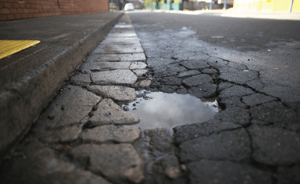The stubborn La Niña is expected to last till at least the end of 2022, impacting weather and climate. This is bad news for our roads.
ARRB believes the timely collection of road condition data in conjunction with regular road maintenance is key to preventing the formation of potholes on our roads.
After being locked up inside all winter trying to escape the cold temperatures, Australians are excited about spring and summer.
But the latest announcement from the World Meteorological Organisation (WMO) is going to disappoint many as we have been warned to brace for yet another La Niña summer.
This means more wet weather for us for the third consecutive year. This also means more water on our roads.
Why does it matter? Let’s have a look at a few challenges faced by road managers in Australia.
Following recent flooding events, most road users have observed the formation of potholes on our roads. What can road managers do during their road repair to prevent potholes if it floods again?
Water is the road’s number one arch-nemesis.
Any repair should aim to reduce the amount of water penetrating the road surface by sealing cracks in the top layer of the road (also known as the asphalt).
Patching potholes is a short-term solution but it does not address the underlying issue as patches have a limited life span.
A better solution consists of sealing cracks but this option does not add any structural strength to the pavement.
Better long-term solutions include road overlays and road reconstruction but these are costly options. Most of the time, the most adequate option for local road managers is to ensure that the asphalt is refreshed and replaced as frequently as it needs to be.
Why are some roads more susceptible to potholes forming than other roads?
Heavily-trafficked roads, especially with a large share of heavy vehicle traffic, or poorly maintained roads are most susceptible to cracks, hence creating the conditions for water penetration, and potholes subsequently.
What's the best way to ensure the strongest structural integrity of roads against flooding?
ARRB advocates for building road maintenance programs based on empirical evidence collected by data collection vehicles such as ARRB’s Intelligent Pavement Assessment Vehicle (iPAVE).
The iPAVE is ARRB’s latest generation Traffic Speed Deflectometer vehicle. It conducts pavement strength testing in a single pass along the road, providing an accurate, cost-effective way of measuring the quality of a road surface and its sub-surface.
The high accuracy and resolution of the iPAVE enable engineers to pinpoint areas where the pavement may be subject to failure, allowing local governments and road agencies the opportunity to decide where best to spend their valuable maintenance dollars.
For more information on pothole prevention and innovative repair, please contact us at https://www.arrb.com.au/contact-us
